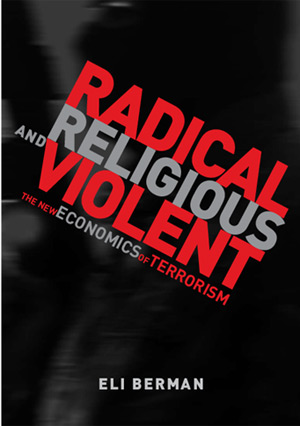
Why are the Taliban such a threat in Afghanistan? And why are violent radical Islamists such resilient terrorists? You won’t believe this but the answer is communism. I’m not kidding. Not capital C Communism, the discredited ideology of the Soviet Union, but mutual aid, as practiced in communes. This might sound like a joke from The Colbert Report—but stick with me.
Religious extremists such as the Taliban are incredibly successful rebels. The Taliban controlled Afghanistan, and we now know how hard that is. Their success cannot be solely due to the Taliban’s theology, which is shared by many rebel groups, most of which are flimsy organizations that quickly crumble.
So what is the Taliban’s secret? Well, the single biggest threats to terrorist organizations are leaks and defection. Radical religious organizations tend to succeed because they can select recruits carefully to create defection-resistant organizations. How do they resist defection? Communism. Religious radicals, such as the Amish, Hutterites, and Ultra-Orthodox Jews, are masters of mutual aid, creating tight-knit communities that are incredibly supportive of their members.
Yet economists (like me) know that mutual aid shouldn’t work in large communities, since individuals pursuing their own self-interest will shirk their responsibilities to the commune, which will then unravel. In fact, mutual aid communes generally do unravel. But not those run by religious radicals—they carefully select new members and monitor the behavior or existing members through sacrifices and prohibitions. The latter are surprisingly similar among religious radicals of vastly different religious traditions. (Economists call that structure a “club,” and Larry Iannaccone of Chapman University is responsible for the insight.)
One more logical step: Once the shirking problem is solved in the mutual aid community, controlling defection is much easier in the violent sub-group—since members have been screened for loyalty and are well-monitored.
What’s the evidence for this communist conspiracy? Religious radicals with a social-service provision base, such as Hamas, Hezbollah, Sadr’s Mahdi Army, and the Taliban, are much more effective at violence than groups that share the same theology but lack a service provision base, such as the Palestinian Islamic Jihad.
“Radical religious organizations tend to succeed because they can select recruits carefully to create defection-resistant organizations. How do they resist defection? Communism. Religious radicals, such as the Amish, Hutterites, and Ultra-Orthodox Jews, are masters of mutual aid, creating tight-knit communities that are incredibly supportive of their members.”
My book offers a fresh way of understanding insurgency and terrorism. I outline a constructive approach to confronting localized insurgencies like those in Afghanistan and Pakistan, and the international terrorism that now threatens most Western countries.
The threat is limited to a very small number of organizations, only those capable of sustainable violent acts without leaks and defection. The U.S. State Department lists only 39 such organizations—less than half are radical Islamists. So why not concentrate on undermining the benign organizational bases of these few organizations? This is best done by helping host governments compete directly in the provision of the benign services that radical Islamists provide to their members: security, education, health care, justice, welfare services, and political representation.
Has this approach ever worked? Gamal Abdul Nasser managed it in the 1950s when he confronted the Egyptian Muslim Brotherhood, the prototypical modern radical Islamists. Nasser’s arresting of thousands of leaders is pretty standard—but he also nationalized the vast social service provision network that the Brotherhood had developed, successfully suppressing them for over two decades.
This constructive tactic has additional advantages. It carries no ideological baggage; allies, local governments, and NGOs can wholeheartedly sign on. It also plays to the strengths of western democracies: our resources and capacity for strong governance and economic growth.
If improving governance works, then why is Afghanistan going so badly? Perhaps because we misunderstand the enemy. In Iraq the insurgents may have been less a club, and so succumbed to a more standard “hearts and minds” governance and security enhancement approach, in which noncombatants rat out insurgents. The Taliban in Afghanistan may be more defection-proof, leaking less information. Undermining their organizational strength would require competing directly with their organizational base, which is currently outside Pakistan, in North Waziristan and Baluchistan.
Is this all just a liberal rant? No. It’s based on peer-reviewed empirical research published in scholarly journals. It is also informed by my own experience as a counterinsurgent and by conversations and consultation with current practitioners.
The final chapter of Radical, Religious, and Violent examines religious radicalism in a historical context. Having established earlier in the book why religious radicals can be lethal terrorists and especially effective rebels if they so choose, I proceed to examine the sources of religious radicalism.
Adam Smith, the originator of modern economics, was concerned about religious freedom and political violence. “Times of violent religious controversy have generally been times of equally violent political faction,” wrote Smith in 1776.
And Menno Simons, the original Mennonite, railed like a modern Jihadist against the corruption and moral bankruptcy of the established order. Consider Simons’s words in his 1539 Foundation of Christian Doctrine:
“We find in your houses and courts nothing but sparkling pomp and showy dress, boldness and presumptuousness of heart, insatiable avarice, hatred and envy, backbiting, betraying, harloting, seduction, gaming, carousing, dancing, swearing, stabbing, and violence…. The pitiful moaning and misery of the wretched men does not reach your ears. The sweat of the poor we find in your house, and the innocent blood on your hands.”
The Mennonites are pacifists today, though their fellow Anabaptists were often violent in the chaotic period during which both sects first emerged. Anabaptist sects were cruelly repressed in Europe, even when they practiced strict pacifism. Why are some religious radicals benign, like the present day Amish, while others are violent, like Hezbollah, Lashkar e Taiba, or the Münster rebels of 1532?
To answer those questions I return to Menno Simons and the sixteenth-century European roots of modern Christian religious radicalism, looking for lessons for how governments should approach twenty-first-century radical Islam.
Surprisingly, Adam Smith and David Hume, the giants of eighteenth-century social science, each had an answer. Hume argued for state religion, as it would transform rabble-rousing clerics into harmless and indolent civil servants. Smith made a classic argument for religious freedom, on the grounds that competition would breed tolerance. In retrospect, countries that have followed Smith’s advice about competitive markets and religious tolerance have created a shared juggernaut of prosperity, technological progress and cultural creativity.

“The Mennonites are pacifists today, though their fellow Anabaptists were often violent in the chaotic period during which both sects first emerged.”
This book is freakonomics about terrorism and insurgency, an attempt to apply an economist’s toolkit to these urgent threats. What’s in that toolkit? Behavioral models that assume rational individuals generate testable propositions, which are then exposed to data. We then keep the models that are not refuted (and quietly suppress the rest).
Amazingly enough, this works. We can explain much of the surprising behavior of religious radicals (benign and violent) with economic reasoning. Moreover, that reasoning has testable implications that survive exposure to data. Most importantly, this same logic suggests that religious radicals respond to incentives, so that we can contain the threat posed by violent religious radicals through methods that complement coercive force with constructive, incentive-based methods. Those constructive methods range from rewards for defection to targeted programs to improve governance.


Eli Berman is an associate professor of economics at UC San Diego, research director for international security studies at the UC Institute on Global Conflict and Cooperation, and a research associate at the National Bureau of Economic Research. His research interests include economic development and conflict, the economics of religion, and labor economics. Grants from the National Science Foundation, Homeland Security and the Defense Department have enabled him to study religion, fertility, governance, and insurgency. His latest publications are “Religion, Terrorism, and Public Goods: Testing the Club Model,” with David Laitin, in the Journal of Public Economics (2008), and “The Economics of Religion,” with Laurence Iannaccone, in the New Palgrave Encyclopedia of Economics. Berman received his Ph.D. in economics from Harvard University. He twitters a real time annotated bibliography at “clubmodel.”